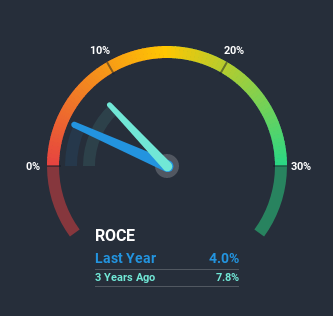What Do The Returns On Capital At AYM Syntex (NSE:AYMSYNTEX) Tell Us?
If we want to find a potential multi-bagger, often there are underlying trends that can provide clues. One common approach is to try and find a company with returns on capital employed (ROCE) that are increasing, in conjunction with a growing amount of capital employed. Put simply, these types of businesses are compounding machines, meaning they are continually reinvesting their earnings at ever-higher rates of return. Having said that, from a first glance at AYM Syntex (NSE:AYMSYNTEX) we aren't jumping out of our chairs at how returns are trending, but let's have a deeper look.
Return On Capital Employed (ROCE): What is it?
Just to clarify if you're unsure, ROCE is a metric for evaluating how much pre-tax income (in percentage terms) a company earns on the capital invested in its business. The formula for this calculation on AYM Syntex is:
Return on Capital Employed = Earnings Before Interest and Tax (EBIT) ÷ (Total Assets - Current Liabilities)
0.04 = ₹195m ÷ (₹7.6b - ₹2.7b) (Based on the trailing twelve months to September 2020).
So, AYM Syntex has an ROCE of 4.0%. In absolute terms, that's a low return and it also under-performs the Luxury industry average of 8.3%.
Check out our latest analysis for AYM Syntex

Historical performance is a great place to start when researching a stock so above you can see the gauge for AYM Syntex's ROCE against it's prior returns. If you're interested in investigating AYM Syntex's past further, check out this free graph of past earnings, revenue and cash flow.
So How Is AYM Syntex's ROCE Trending?
When we looked at the ROCE trend at AYM Syntex, we didn't gain much confidence. To be more specific, ROCE has fallen from 22% over the last five years. And considering revenue has dropped while employing more capital, we'd be cautious. If this were to continue, you might be looking at a company that is trying to reinvest for growth but is actually losing market share since sales haven't increased.
The Bottom Line
In summary, we're somewhat concerned by AYM Syntex's diminishing returns on increasing amounts of capital. Long term shareholders who've owned the stock over the last five years have experienced a 65% depreciation in their investment, so it appears the market might not like these trends either. Unless there is a shift to a more positive trajectory in these metrics, we would look elsewhere.
On a final note, we found 4 warning signs for AYM Syntex (2 are a bit concerning) you should be aware of.
For those who like to invest in solid companies, check out this free list of companies with solid balance sheets and high returns on equity.
If you decide to trade AYM Syntex, use the lowest-cost* platform that is rated #1 Overall by Barron’s, Interactive Brokers. Trade stocks, options, futures, forex, bonds and funds on 135 markets, all from a single integrated account. Promoted
New: Manage All Your Stock Portfolios in One Place
We've created the ultimate portfolio companion for stock investors, and it's free.
• Connect an unlimited number of Portfolios and see your total in one currency
• Be alerted to new Warning Signs or Risks via email or mobile
• Track the Fair Value of your stocks
This article by Simply Wall St is general in nature. It does not constitute a recommendation to buy or sell any stock, and does not take account of your objectives, or your financial situation. We aim to bring you long-term focused analysis driven by fundamental data. Note that our analysis may not factor in the latest price-sensitive company announcements or qualitative material. Simply Wall St has no position in any stocks mentioned.
*Interactive Brokers Rated Lowest Cost Broker by StockBrokers.com Annual Online Review 2020
Have feedback on this article? Concerned about the content? Get in touch with us directly. Alternatively, email editorial-team@simplywallst.com.
About NSEI:AYMSYNTEX
AYM Syntex
Manufactures and sells polyester filament, nylon filament, and bulk continuous filament yarns for the textile and floor covering industries in India, Australia, European Union, New Zealand, the United Kingdom, the United States, internationally.
Excellent balance sheet and slightly overvalued.
Market Insights
Community Narratives



